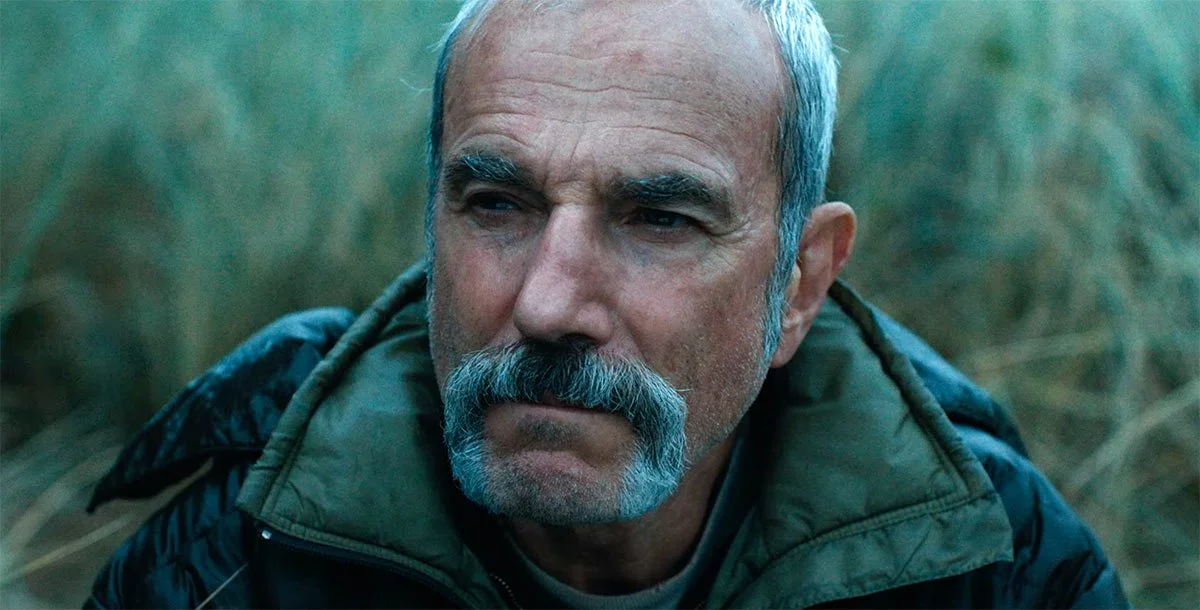Review: ‘Anemone’ aims for profound but settles for silly
2025 / Dir. Ronan Day-Lewis
☆ 2.5/5
Watch if you like: There Will Be Blood but it’s just about why he abandoned his child for two hours, and sometimes there’s a ghost or anthropomorphic CGI creature for some reason.
Daniel Day-Lewis’s first film back after “retiring” nearly a decade ago is certainly… something. A passion project for the esteemed actor—who co-wrote the script with his son, Ronan, in his full-length directorial debut—Anemone has many long stretches where nothing much happens, set to stunningly photographed forest images, and then will suddenly have a music video-like sequence of drunken dancing set to heavy synth music a la the Stranger Things soundtrack. Or, there’s a spectral, magical-realist haunting. Or, an anthropomorphic creature appears. Or… I could go on, but you get the point.
Day-Lewis and Bean are Ray and Jem Stoker, estranged brothers who haven’t seen each other in twenty years after Ray abandoned his family and absconded to the woods. After Ray’s biological and Jem’s adopted son Brian (Samuel Bottomley) gets into trouble after nearly beating a fellow soldier to death, Jem ventures out into the woods to try to convince his brother to finally return to society in hopes that Brian getting to know Ray will relieve him of his inner turmoil.
Why Ray abandoned society, other than the occasional jaunt to the local pub for a pint, is treated as a big mystery that the film is building towards, even though a beginning pan over a child’s scroll drawing of “The Troubles” in Ireland already clues us into what we’re in store for. What that means for the viewer is that there’s a lot of unnecessary denial and waiting for Ray to unburden himself and reveal what happened when he was in the British Army, deployed to Northern Ireland.
Case in point: Jem delivers a letter to Ray from his wife, and Ray’s ex, Nessa (an underutilized Samantha Morton), explaining the situation with Brian. Ray doesn’t read the letter, and Jem waits around for days. In the meantime, they wander. They go for walks through the woods, to the beach, and past a neon-lit amusement park. They dance or brawl with each other, set to Bobby Krlic’s, aka The Haxan Cloak, heavy-handed score that bounces between dense, M83-esque electronic shoegaze and a similarly eerie mix of synth and indie folk, as seen in Alex G’s work in Jane Schoenbrun’s films.
Sean Bean doesn’t have much to do here as Jem, even as the two veteran actors have a natural rapport. This is really the Daniel Day-Lewis show, and he makes a meal out of a script that can feel like it would have made for a great community theater production rather than a major actor’s comeback. His Ray Stoker is Daniel Plainview if, instead of an oil baron, he were your angry yet hilarious and weird uncle you see once a year who never seems to change.
Day-Lewis has two major monologues that give us hope he’ll reunite with Paul Thomas Anderson for his next film. The first is both a horrifying and ridiculous revenge fantasy against a pedophilic priest. The second is the moment we’re all waiting for when Ray finally unburdens himself and tells Jem what happened back in Ireland, which is delivered passionately by Day-Lewis but doesn’t pack enough of a wallop for all the thumb-twiddling it took to get there. It’s also undercut, literally, by a blander monologue told by Nessa to her son about the little she knows about Ray’s disappearance.
This may also be why his son, Ronan, and cinematographer Ben Fordesman go all out between the static shots of talking. The camera is regularly pushing in, pulling out, tilting, panning, or handheld shakily. The camerawork becomes increasingly audacious as the film introduces elements of magical realism, such as a particularly spectacular sequence where the camera moves to hover over Ray as he sleeps. When the frame reaches his feet, the camera tilts upwards to reveal a ghostly visage of Samantha Morton hovering over him.
These “supernatural” moments in this film, I assume, are intended to reflect Ray’s mental state, but they don’t align with the relative simplicity of the material. Ray is a cranky, lonely man, chewed up and spat out by the war machine, befitting the small character drama that makes up half of this film. To justify many of the film’s ridiculous choices later in the movie, you would need a story of Park Chan-wook or Lars Von Trier-level audacity to put Ray through. As it stands, the last handful of sequences aim to be profound but instead settle for silly.
It’s unfortunate Anemone just doesn’t fit together. The early part of the film is visually breathtaking, with a captivating Daniel Day-Lewis character and the promise of an intriguing exploration of a man with a loose grip on reality trying to find his way back. All the elements were there for a fascinating movie, but the father-son script ultimately falters by not developing any of the other characters and stretching out its central mystery (which is barely a mystery) until the breaking point—depriving the film of the big emotional release it so desires.

